Amin Heyrani Nobari
CAD-Coder: An Open-Source Vision-Language Model for Computer-Aided Design Code Generation
May 20, 2025Abstract:Efficient creation of accurate and editable 3D CAD models is critical in engineering design, significantly impacting cost and time-to-market in product innovation. Current manual workflows remain highly time-consuming and demand extensive user expertise. While recent developments in AI-driven CAD generation show promise, existing models are limited by incomplete representations of CAD operations, inability to generalize to real-world images, and low output accuracy. This paper introduces CAD-Coder, an open-source Vision-Language Model (VLM) explicitly fine-tuned to generate editable CAD code (CadQuery Python) directly from visual input. Leveraging a novel dataset that we created--GenCAD-Code, consisting of over 163k CAD-model image and code pairs--CAD-Coder outperforms state-of-the-art VLM baselines such as GPT-4.5 and Qwen2.5-VL-72B, achieving a 100% valid syntax rate and the highest accuracy in 3D solid similarity. Notably, our VLM demonstrates some signs of generalizability, successfully generating CAD code from real-world images and executing CAD operations unseen during fine-tuning. The performance and adaptability of CAD-Coder highlights the potential of VLMs fine-tuned on code to streamline CAD workflows for engineers and designers. CAD-Coder is publicly available at: https://github.com/anniedoris/CAD-Coder.
Activation-Informed Merging of Large Language Models
Feb 04, 2025Abstract:Model merging, a method that combines the parameters and embeddings of multiple fine-tuned large language models (LLMs), offers a promising approach to enhance model performance across various tasks while maintaining computational efficiency. This paper introduces Activation-Informed Merging (AIM), a technique that integrates the information from the activation space of LLMs into the merging process to improve performance and robustness. AIM is designed as a flexible, complementary solution that is applicable to any existing merging method. It aims to preserve critical weights from the base model, drawing on principles from continual learning~(CL) and model compression. Utilizing a task-agnostic calibration set, AIM selectively prioritizes essential weights during merging. We empirically demonstrate that AIM significantly enhances the performance of merged models across multiple benchmarks. Our findings suggest that considering the activation-space information can provide substantial advancements in the model merging strategies for LLMs with up to 40\% increase in benchmark performance.
LInK: Learning Joint Representations of Design and Performance Spaces through Contrastive Learning for Mechanism Synthesis
May 31, 2024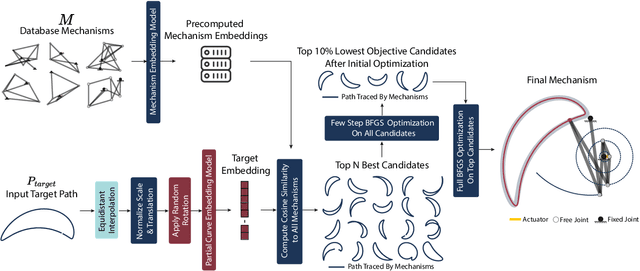

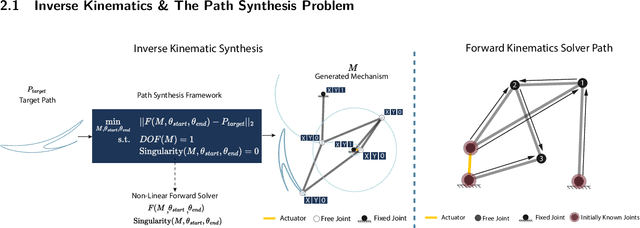
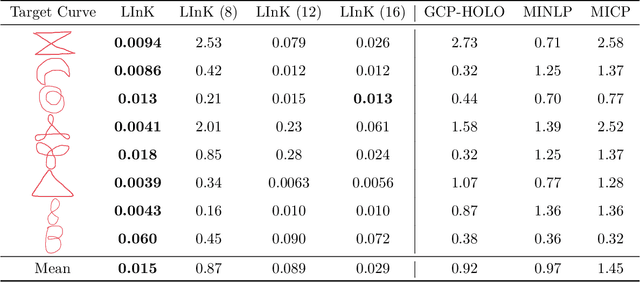
Abstract:In this paper, we introduce LInK, a novel framework that integrates contrastive learning of performance and design space with optimization techniques for solving complex inverse problems in engineering design with discrete and continuous variables. We focus on the path synthesis problem for planar linkage mechanisms. By leveraging a multi-modal and transformation-invariant contrastive learning framework, LInK learns a joint representation that captures complex physics and design representations of mechanisms, enabling rapid retrieval from a vast dataset of over 10 million mechanisms. This approach improves precision through the warm start of a hierarchical unconstrained nonlinear optimization algorithm, combining the robustness of traditional optimization with the speed and adaptability of modern deep learning methods. Our results on an existing benchmark demonstrate that LInK outperforms existing methods with 28 times less error compared to a state-of-the-art approach while taking 20 times less time on an existing benchmark. Moreover, we introduce a significantly more challenging benchmark, named LINK-ABC, which involves synthesizing linkages that trace the trajectories of English capital alphabets - an inverse design benchmark task that existing methods struggle with due to large non-linearities and tiny feasible space. Our results demonstrate that LInK not only advances the field of mechanism design but also broadens the applicability of contrastive learning and optimization to other areas of engineering.
BIKED++: A Multimodal Dataset of 1.4 Million Bicycle Image and Parametric CAD Designs
Feb 09, 2024Abstract:This paper introduces a public dataset of 1.4 million procedurally-generated bicycle designs represented parametrically, as JSON files, and as rasterized images. The dataset is created through the use of a rendering engine which harnesses the BikeCAD software to generate vector graphics from parametric designs. This rendering engine is discussed in the paper and also released publicly alongside the dataset. Though this dataset has numerous applications, a principal motivation is the need to train cross-modal predictive models between parametric and image-based design representations. For example, we demonstrate that a predictive model can be trained to accurately estimate Contrastive Language-Image Pretraining (CLIP) embeddings from a parametric representation directly. This allows similarity relations to be established between parametric bicycle designs and text strings or reference images. Trained predictive models are also made public. The dataset joins the BIKED dataset family which includes thousands of mixed-representation human-designed bicycle models and several datasets quantifying design performance. The code and dataset can be found at: https://github.com/Lyleregenwetter/BIKED_multimodal/tree/main
NITO: Neural Implicit Fields for Resolution-free Topology Optimization
Feb 07, 2024



Abstract:Topology optimization is a critical task in engineering design, where the goal is to optimally distribute material in a given space for maximum performance. We introduce Neural Implicit Topology Optimization (NITO), a novel approach to accelerate topology optimization problems using deep learning. NITO stands out as one of the first frameworks to offer a resolution-free and domain-agnostic solution in deep learning-based topology optimization. NITO synthesizes structures with up to seven times better structural efficiency compared to SOTA diffusion models and does so in a tenth of the time. In the NITO framework, we introduce a novel method, the Boundary Point Order-Invariant MLP (BPOM), to represent boundary conditions in a sparse and domain-agnostic manner, moving away from expensive simulation-based approaches. Crucially, NITO circumvents the domain and resolution limitations that restrict Convolutional Neural Network (CNN) models to a structured domain of fixed size -- limitations that hinder the widespread adoption of CNNs in engineering applications. This generalizability allows a single NITO model to train and generate solutions in countless domains, eliminating the need for numerous domain-specific CNNs and their extensive datasets. Despite its generalizability, NITO outperforms SOTA models even in specialized tasks, is an order of magnitude smaller, and is practically trainable at high resolutions that would be restrictive for CNNs. This combination of versatility, efficiency, and performance underlines NITO's potential to transform the landscape of engineering design optimization problems through implicit fields.
Conformal Predictions Enhanced Expert-guided Meshing with Graph Neural Networks
Aug 14, 2023Abstract:Computational Fluid Dynamics (CFD) is widely used in different engineering fields, but accurate simulations are dependent upon proper meshing of the simulation domain. While highly refined meshes may ensure precision, they come with high computational costs. Similarly, adaptive remeshing techniques require multiple simulations and come at a great computational cost. This means that the meshing process is reliant upon expert knowledge and years of experience. Automating mesh generation can save significant time and effort and lead to a faster and more efficient design process. This paper presents a machine learning-based scheme that utilizes Graph Neural Networks (GNN) and expert guidance to automatically generate CFD meshes for aircraft models. In this work, we introduce a new 3D segmentation algorithm that outperforms two state-of-the-art models, PointNet++ and PointMLP, for surface classification. We also present a novel approach to project predictions from 3D mesh segmentation models to CAD surfaces using the conformal predictions method, which provides marginal statistical guarantees and robust uncertainty quantification and handling. We demonstrate that the addition of conformal predictions effectively enables the model to avoid under-refinement, hence failure, in CFD meshing even for weak and less accurate models. Finally, we demonstrate the efficacy of our approach through a real-world case study that demonstrates that our automatically generated mesh is comparable in quality to expert-generated meshes and enables the solver to converge and produce accurate results. Furthermore, we compare our approach to the alternative of adaptive remeshing in the same case study and find that our method is 5 times faster in the overall process of simulation. The code and data for this project are made publicly available at https://github.com/ahnobari/AutoSurf.
LINKS: A dataset of a hundred million planar linkage mechanisms for data-driven kinematic design
Aug 30, 2022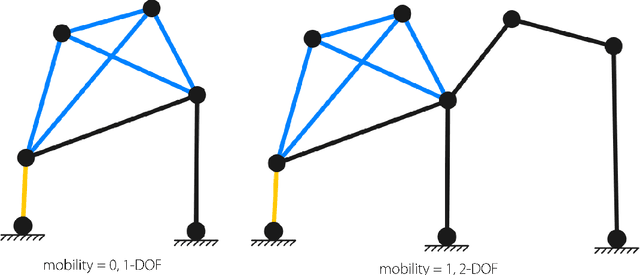

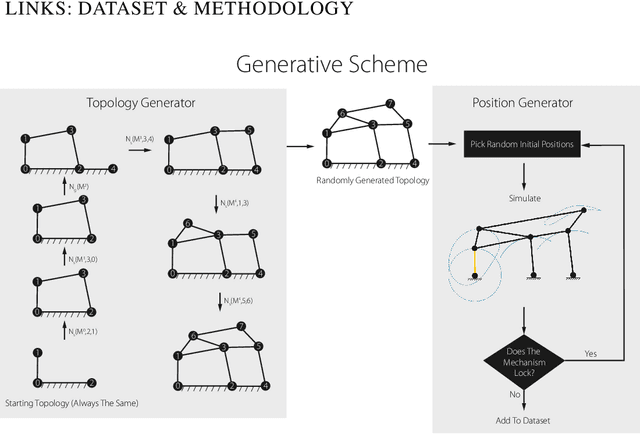
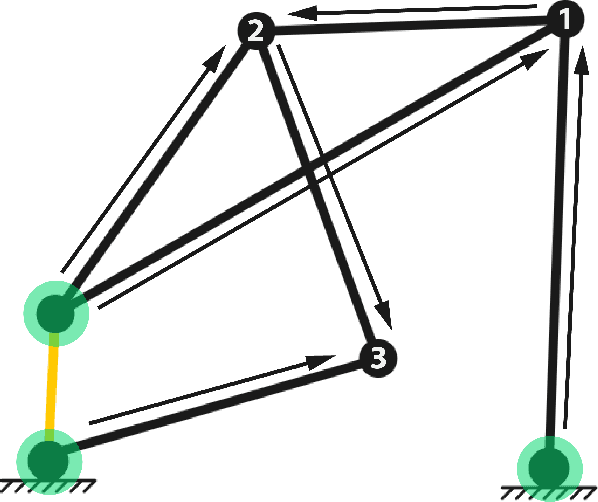
Abstract:In this paper, we introduce LINKS, a dataset of 100 million one degree of freedom planar linkage mechanisms and 1.1 billion coupler curves, which is more than 1000 times larger than any existing database of planar mechanisms and is not limited to specific kinds of mechanisms such as four-bars, six-bars, \etc which are typically what most databases include. LINKS is made up of various components including 100 million mechanisms, the simulation data for each mechanism, normalized paths generated by each mechanism, a curated set of paths, the code used to generate the data and simulate mechanisms, and a live web demo for interactive design of linkage mechanisms. The curated paths are provided as a measure for removing biases in the paths generated by mechanisms that enable a more even design space representation. In this paper, we discuss the details of how we can generate such a large dataset and how we can overcome major issues with such scales. To be able to generate such a large dataset we introduce a new operator to generate 1-DOF mechanism topologies, furthermore, we take many steps to speed up slow simulations of mechanisms by vectorizing our simulations and parallelizing our simulator on a large number of threads, which leads to a simulation 800 times faster than the simple simulation algorithm. This is necessary given on average, 1 out of 500 candidates that are generated are valid~(and all must be simulated to determine their validity), which means billions of simulations must be performed for the generation of this dataset. Then we demonstrate the depth of our dataset through a bi-directional chamfer distance-based shape retrieval study where we show how our dataset can be used directly to find mechanisms that can trace paths very close to desired target paths.
Deep Generative Models in Engineering Design: A Review
Oct 21, 2021

Abstract:Automated design synthesis has the potential to revolutionize the modern human design process and improve access to highly optimized and customized products across countless industries. Successfully adapting generative Machine Learning to design engineering may be the key to such automated design synthesis and is a research subject of great importance. We present a review and analysis of Deep Generative Learning models in engineering design. Deep Generative Models (DGMs) typically leverage deep networks to learn from an input dataset and learn to synthesize new designs. Recently, DGMs such as Generative Adversarial Networks (GANs), Variational Autoencoders (VAEs), feedforward Neural Networks (NNs) and certain Deep Reinforcement Learning (DRL) frameworks have shown promising results in design applications like structural optimization, materials design, and shape synthesis. The prevalence of DGMs in Engineering Design has skyrocketed since 2016. Anticipating continued growth, we conduct a review of recent advances with the hope of benefitting researchers interested in DGMs for design. We structure our review as an exposition of the algorithms, datasets, representation methods, and applications commonly used in the current literature. In particular, we discuss key works that have introduced new techniques and methods in DGMs, successfully applied DGMs to a design-related domain, or directly supported development of DGMs through datasets or auxiliary methods. We further identify key challenges and limitations currently seen in DGMs across design fields, such as design creativity, handling complex constraints and objectives, and modeling both form and functional performance simultaneously. In our discussion we identify possible solution pathways as key areas on which to target future work.
PcDGAN: A Continuous Conditional Diverse Generative Adversarial Network For Inverse Design
Jun 07, 2021



Abstract:Engineering design tasks often require synthesizing new designs that meet desired performance requirements. The conventional design process, which requires iterative optimization and performance evaluation, is slow and dependent on initial designs. Past work has used conditional generative adversarial networks (cGANs) to enable direct design synthesis for given target performances. However, most existing cGANs are restricted to categorical conditions. Recent work on Continuous conditional GAN (CcGAN) tries to address this problem, but still faces two challenges: 1) it performs poorly on non-uniform performance distributions, and 2) the generated designs may not cover the entire design space. We propose a new model, named Performance Conditioned Diverse Generative Adversarial Network (PcDGAN), which introduces a singular vicinal loss combined with a Determinantal Point Processes (DPP) based loss function to enhance diversity. PcDGAN uses a new self-reinforcing score called the Lambert Log Exponential Transition Score (LLETS) for improved conditioning. Experiments on synthetic problems and a real-world airfoil design problem demonstrate that PcDGAN outperforms state-of-the-art GAN models and improves the conditioning likelihood by 69% in an airfoil generation task and up to 78% in synthetic conditional generation tasks and achieves greater design space coverage. The proposed method enables efficient design synthesis and design space exploration with applications ranging from CAD model generation to metamaterial selection.
CreativeGAN: Editing Generative Adversarial Networks for Creative Design Synthesis
Mar 10, 2021



Abstract:Modern machine learning techniques, such as deep neural networks, are transforming many disciplines ranging from image recognition to language understanding, by uncovering patterns in big data and making accurate predictions. They have also shown promising results for synthesizing new designs, which is crucial for creating products and enabling innovation. Generative models, including generative adversarial networks (GANs), have proven to be effective for design synthesis with applications ranging from product design to metamaterial design. These automated computational design methods can support human designers, who typically create designs by a time-consuming process of iteratively exploring ideas using experience and heuristics. However, there are still challenges remaining in automatically synthesizing `creative' designs. GAN models, however, are not capable of generating unique designs, a key to innovation and a major gap in AI-based design automation applications. This paper proposes an automated method, named CreativeGAN, for generating novel designs. It does so by identifying components that make a design unique and modifying a GAN model such that it becomes more likely to generate designs with identified unique components. The method combines state-of-art novelty detection, segmentation, novelty localization, rewriting, and generative models for creative design synthesis. Using a dataset of bicycle designs, we demonstrate that the method can create new bicycle designs with unique frames and handles, and generalize rare novelties to a broad set of designs. Our automated method requires no human intervention and demonstrates a way to rethink creative design synthesis and exploration.
 Add to Chrome
Add to Chrome Add to Firefox
Add to Firefox Add to Edge
Add to Edge